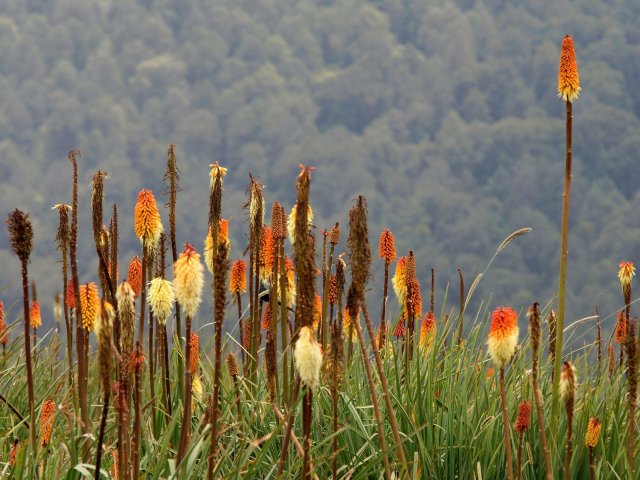Fauna
Ethiopia owes its rich biodiversity to the combination of a tropical location and an altitudinal span ranging from 4,533 meters above sea level to 116 meters below sea level. The country is known for its unusually high level of endemism i.e. plant and animal species found nowhere else in the world. Among vertebrates alone, at least 140 species are unique to Ethiopia, including more than 40 mammals and 18 birds.
The varied flora embraces the world’s most extensive tracts of Afro-alpine moorland, along with a varied mix of forest, savannah, desert, and cultivation.Ethiopia provides refuge to a typical Afro-tropical fauna, ranging from parrot and pelicans to lions and crocodiles, but it is most notable perhaps for endemic species such as the Ethiopian wolf, gelada baboon, and Prince Ruspoli’s turaco.Ethiopia boasts one of the most diverse faunas in Africa. Although most species present are typical of the Afro-tropical region, the fauna also displays affiliations to the Palaearctic region. The Bale Mountains, for instance, protect the only known sub-Saharan breeding populations of Palaearctic birds such as the golden eagle, ruddy shelduck and red-billed chough.
- Of the 280 mammal species recorded in Ethiopia, at least 40 are found nowhere else in the world. Most of these endemics are relatively inconspicuous shrews, rodents and bats, but the list also contains several larger and more striking species. Among these, the best known are the Ethiopian wolf (the world’s rarest wild dog), mountain nyala (a massive spiral-horned antelope), Bale monkey (a bamboo-eater confined to the Harenna Forest), gelada (a grass-eating baboon with a flowing lion-like mane and heart-shaped red chest patch) and Walia ibex (the only goat indigenous to sub-Saharan Africa).
- Other mammals represented in Ethiopia include the acrobatic black-and-white colobus monkey, small numbers of elephant and buffalo, and a subspecies of lion noted for the males’s unusually large black mane.
- Of the 860 bird species recorded in Ethiopia, a full 18 – including the spectacular Prince Ruspoli’s Turaco, Stresemann’s Bush Crow and melodious Abyssinian catbird – are national endemics and a similar number are near-endemics whose range only otherwise extends into Eritrea. The Simien Mountains are the best place in the world to see the mighty lammergeyer displaying its 2-metre wingspan.
- Reptiles recorded in Ethiopia range from the heavyweight Nile crocodile and impressive Nile monitor lizard to several tiny species chameleon. At least 16 reptile species are endemic to Ethiopia, along with 26 amphibian and 33 freshwater fish species.
- Ethiopia’s invertebrate fauna – comprising insects, arachnids, molluscs and the like – is even more diverse. Butterflies alone are represented by around 375 species of which almost 10% are endemic.

Flora
Ethiopia boasts an extremely diverse flora including more than 1,000 species of woody plants (125 of which are endemic) and 736 types of grass.
- Due to its high altitudes, Ethiopia supports the world’s most extensive tracts of Afroalpine moorland and grassland, particularly on the upper slopes of the Bale and Simien massifs. Plants typical of this open habitat include soft green guassa grass, ericaceous heathers and spectacular palm-like giant lobelias.
- Striking plants associated with higher altitudes are the aloe-like ‘red-hot-pokers’ of the genus Kniphofia. The pokers are named for their spear-like orange and red flowers, which usually bloom during the rainy season, and whose copious nectar is attractive to bees and sunbirds.
- The most biodiverse habitat in Ethiopia is closed canopy forest, which covers about 4% of the national landmass. The most important forest blocks are the Harenna Forest in the southern slopes of the Bale Massif, and the extensive montane forests protected in the Biosphere Reserves of the western highlands, which are also where coffee originated.
- A characteristic tree of highland areas is the Abyssinian juniper Juniperus procera, an indigenous conifer recognisable by its needle-like leaves and fragrant herby smell. Other common highland trees include the African Olive Olea Africana.
- The larger rivers and lakes of Ethiopia support strips of riparian forest, while many old churches and monasteries protect small relict forest patches. In such habitats you’ll often find large buttressed trees of the genus Ficus, whose seasonal fruits frequently attract large numbers of monkeys and birds.
- The Rift Valley and others below an altitude of around 2,000m naturally support a typical African cover of wooded savanna, often dominated by thorn trees of the Acacia family.
- The only rose species indigenous to Africa, the Ethiopian rose Rosa abyssinica, a thorny deciduous shrub with fragrant creamy flowers, is common in the highlands around Bale.
- Although outsiders frequent assume Ethiopia to be dominated by desert habitats, only about 30 percent of the country is classified as arid or semi-arid, most if it in the southeastern Somali border area and the Danakil Depression.
- Around 15 percent of Ethiopia’s land is under cultivation and 50 percent is used as pasture. Most farmland consists of private smallholdings used to produce tef (the endemic grain used to make injera), sorghum, millet and corn. Cash crops include coffee and flowers. Agriculture is estimated to account for about 42 percent of GDP, and 84% of exports. It is also the main source of income for 80% of the workforce.

